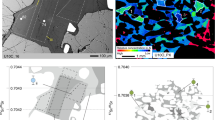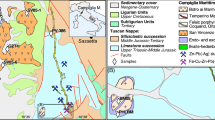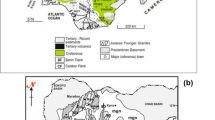Abstract
PRECISE radiometric dating of ophiolites and associated rocks is usually very difficult as the rocks are often altered by ocean floor metamorphism or during tectonic emplacement onto the continental margin. Only age determinations on primary mineral phases can be considered to approximate their initial crystallisation and cooling ages. The K–Ar technique is generally used to date ophiolitic rocks, but even if primary mineral phases are analysed, there is always the uncertainty that the resulting age could have been partially reset by later thermal or tectonic events. The 40Ar–39Ar step heating method is able to detect and often to correct for any partial loss of argon, and thus overcome these problems. We have determined and report here 40Ar–39Ar age spectra for hornblende separates from two unaltered samples of igneous rocks that are interpreted as the initial igneous products of rifting in the Othris region of central Greece. A third hornblende has been analysed from amphibolites believed to have been formed during tectonic emplacement of the Pindos ophiolite (Fig. 1). The ages suggest that the initial rifting began in Othris in the Permo–Triassic (∼248 Myr), while tectonic emplacement of the Pindos ophiolite occurred in the middle Jurassic time (∼180 Myr).
This is a preview of subscription content, access via your institution
Access options
Subscribe to this journal
Receive 51 print issues and online access
$199.00 per year
only $3.90 per issue
Buy this article
- Purchase on Springer Link
- Instant access to full article PDF
Prices may be subject to local taxes which are calculated during checkout
Similar content being viewed by others
References
Hynes, A. J. Can. J. Earth Sci. 11, 842 (1974).
Smith, A. G. et al. Eclog. Geol. Helv. 68, 463 (1975).
Hynes, A. J., Nisbet, E. G., Smith, A. G., Welland, M. J. P. & Rex, D. C. Z. Deutsch. Geol. Ges. 123, 455 (1972).
Turner, G. in Origin and Distribution of the Elements (ed. Ahrens, L. H.) 387 (Pergamon, Oxford, 1968).
Dallmeyer, R. D. Geochim. cosmochim. Acta. 39, 1655 (1975).
Armstrong, R. L. & McDowall, W. G. Int. Meet. Geochron. Cosmochron. Isotope Geol. Paris (1974).
Nisbet, E. G. & Price, I. Int. Ass. Sedimentol., Spec. Publ. 1, 351 (1974).
Ferrière, J. Bull. Geol. Soc. Fr. 16, 343–363 (1974).
Mercier, J.-L., Vergely, P. & Bebien, J. C. r. Somm. Seanc. Geol., Paris (1975).
Pichon, J. F., Lys, M. C. r. hebd. Séanc. Acad. Sci., Paris 282, 523–526 (1976).
Charvet, J. thesis, Univ. Lille (1978).
Woodcock, N. H. & Robertson, A. H. F. Geology 5, 373 (1977).
Lanphere, M. A., Coleman, R. G., Karamata, S. & Pamic, J. Earth planet. Sci. Lett. 26, 271 (1975).
Okrusch, M., Seidel, M., Kreuzer, H. & Harre, W. Earth planet Sci. Lett. 39, 291 (1978).
Seidel, M., Schliestedt, M., Kreuzer, H. & Harre, W. Geol. J. B 28, 3 (1977).
Steiger, R. H. & Jager, E. Earth planet Sci. Lett. 36, 359 (1977).
Author information
Authors and Affiliations
Rights and permissions
About this article
Cite this article
RODDICK, J., CAMERON, W. & SMITH, A. Permo–Triassic and Jurassic 40Ar–39Ar ages from Greek ophiolites and associated rocks. Nature 279, 788–790 (1979). https://doi.org/10.1038/279788a0
Received:
Accepted:
Issue Date:
DOI: https://doi.org/10.1038/279788a0
This article is cited by
-
The phanerozoic palaeotectonics of Turkey. Part I: an inventory
Mediterranean Geoscience Reviews (2019)
-
The tauride ophiolites of Anatolia (Turkey): A review
Journal of Earth Science (2016)
-
Geodynamic evolution of ophiolites from Albania and Greece (Dinaric-Hellenic belt): one, two, or more oceanic basins?
International Journal of Earth Sciences (2013)
-
Jurassic mountain building and Mesozoic-Cenozoic geodynamic evolution of the Northern Calcareous Alps as proven in the Berchtesgaden Alps (Germany)
Facies (2011)
-
Evidence for Jurassic subduction from the Northern Calcareous Alps (Berchtesgaden; Austroalpine, Germany)
International Journal of Earth Sciences (2011)
Comments
By submitting a comment you agree to abide by our Terms and Community Guidelines. If you find something abusive or that does not comply with our terms or guidelines please flag it as inappropriate.



